
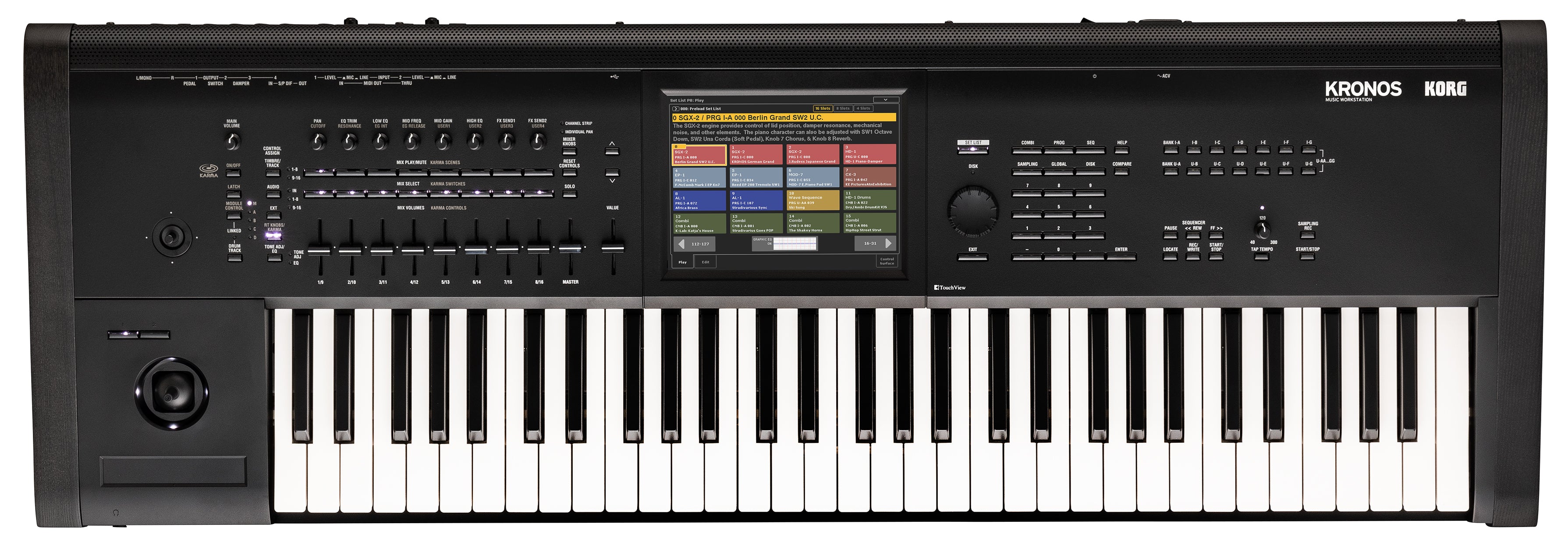
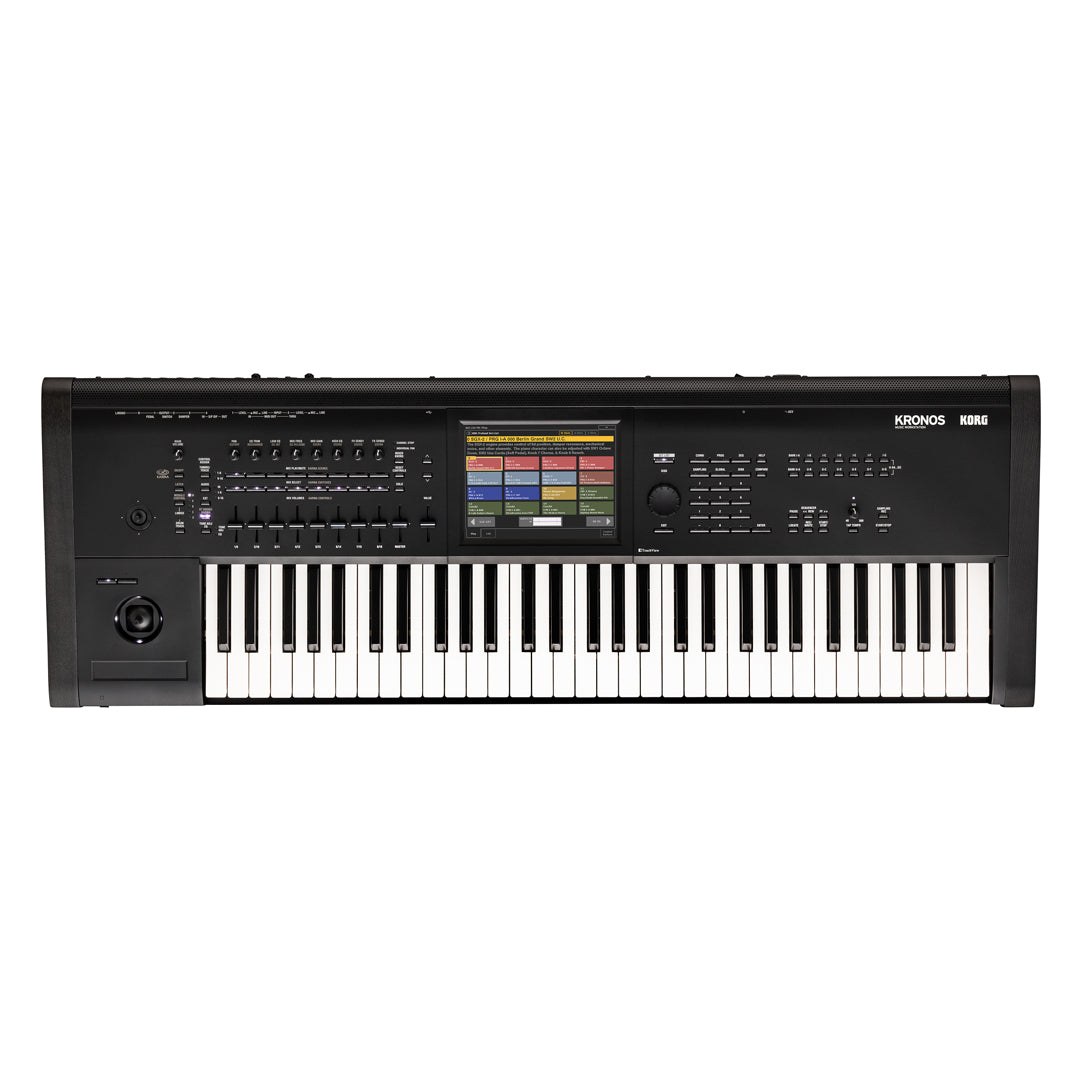
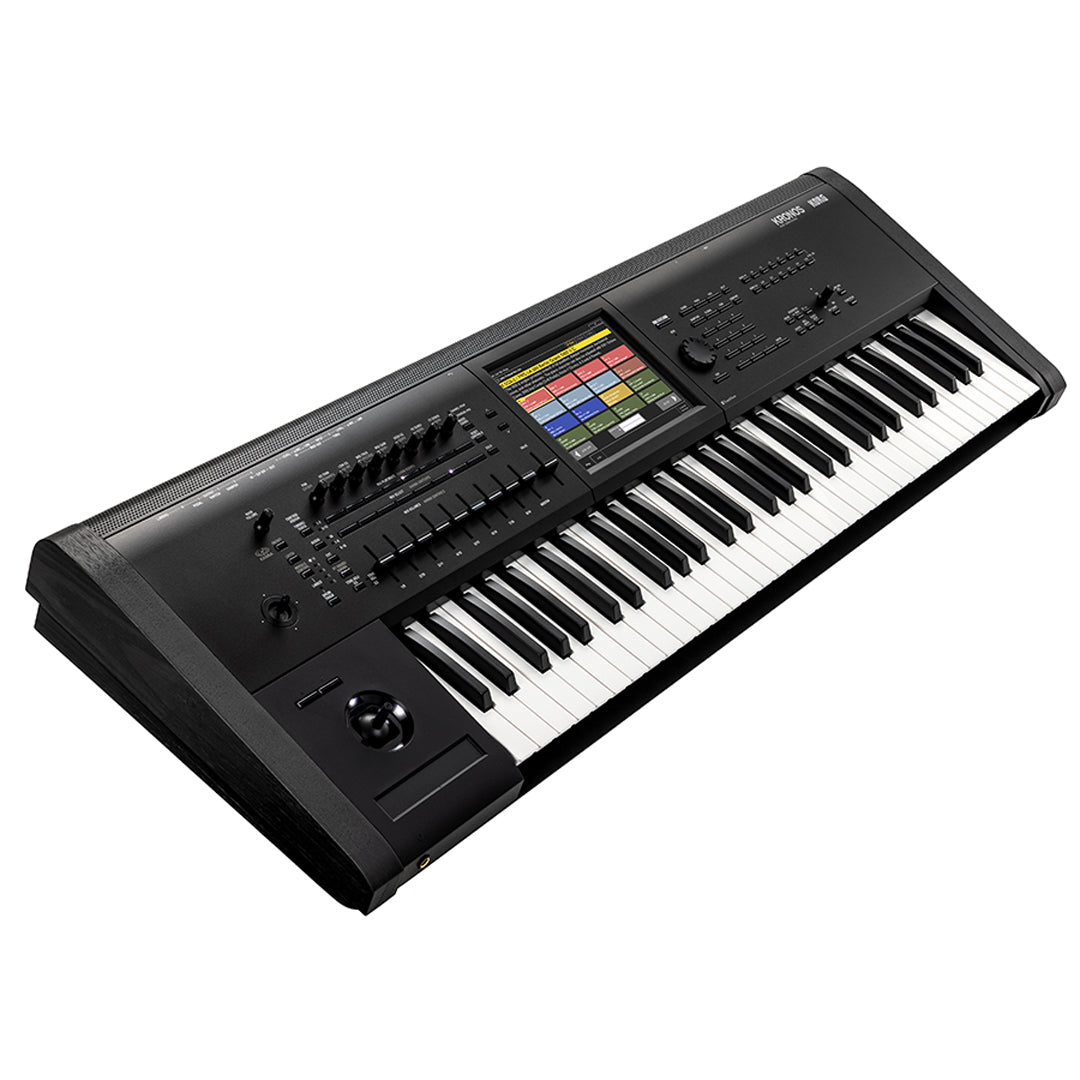
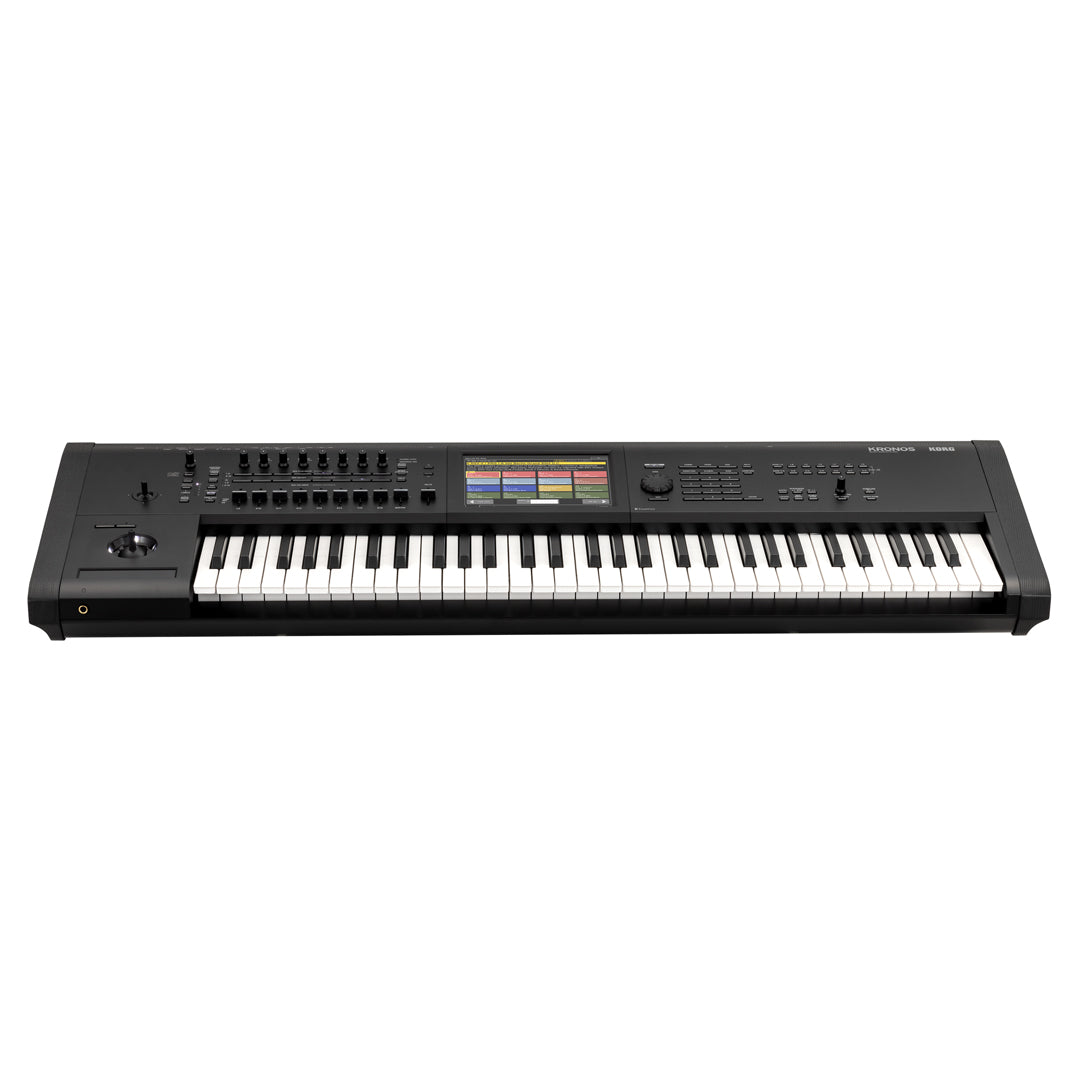
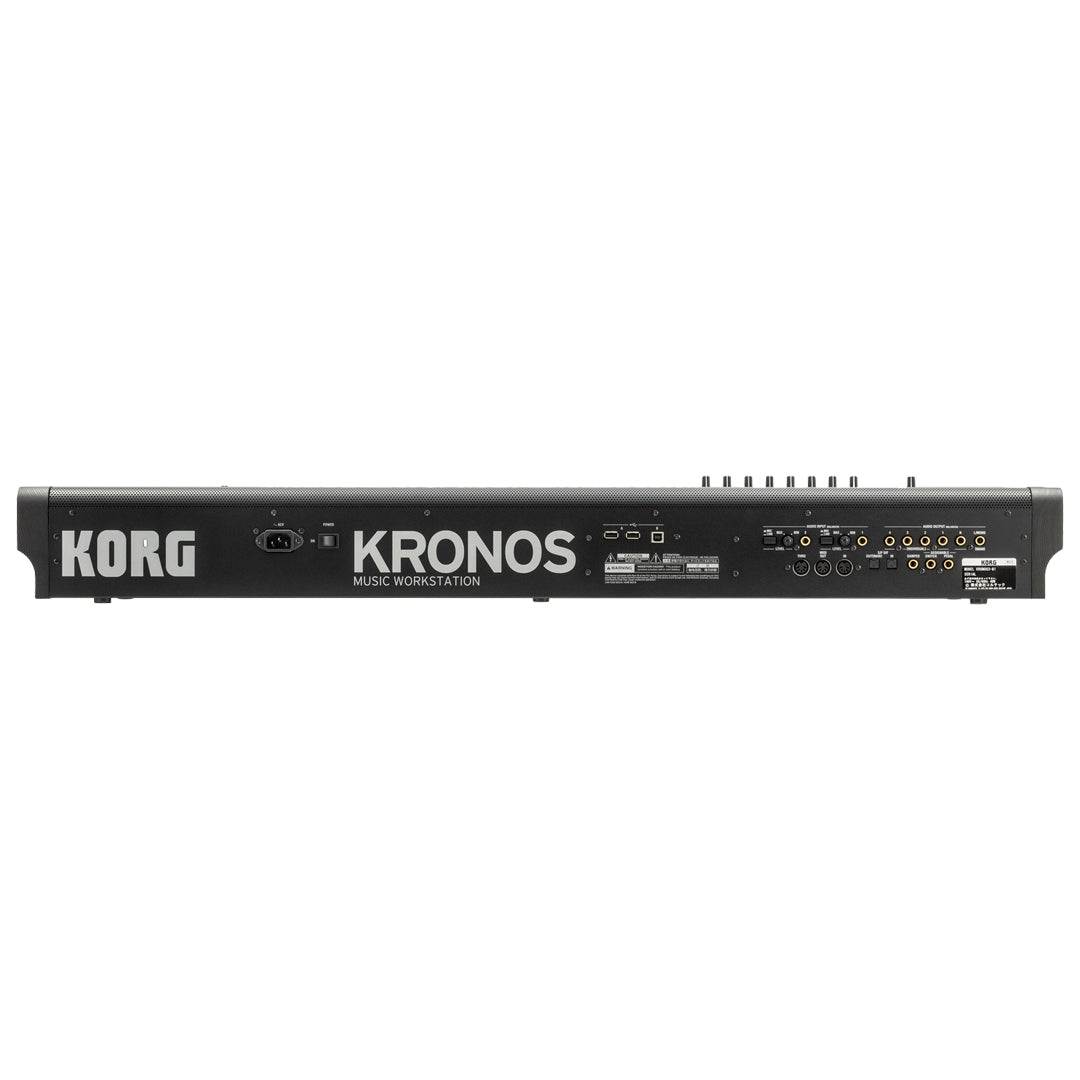
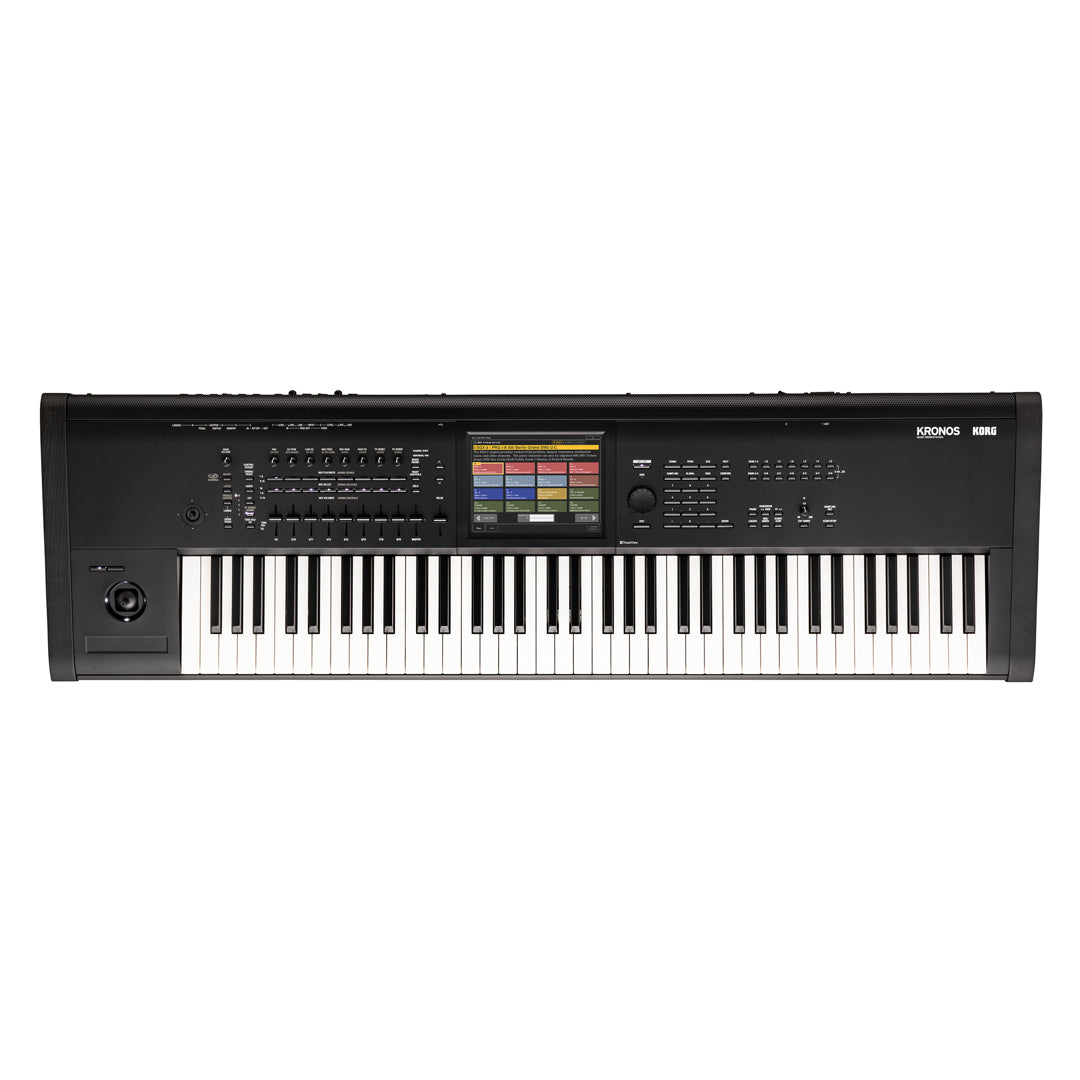

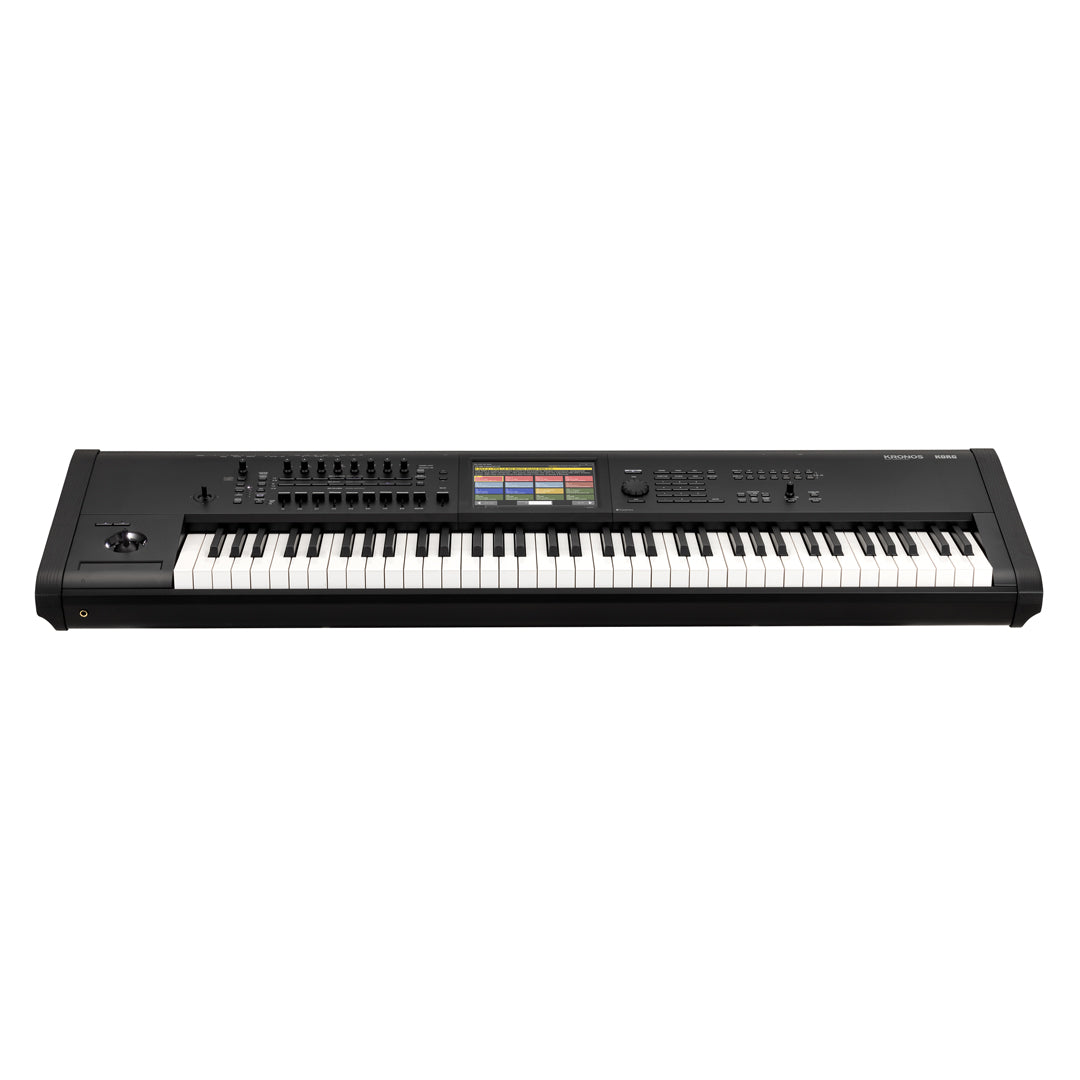
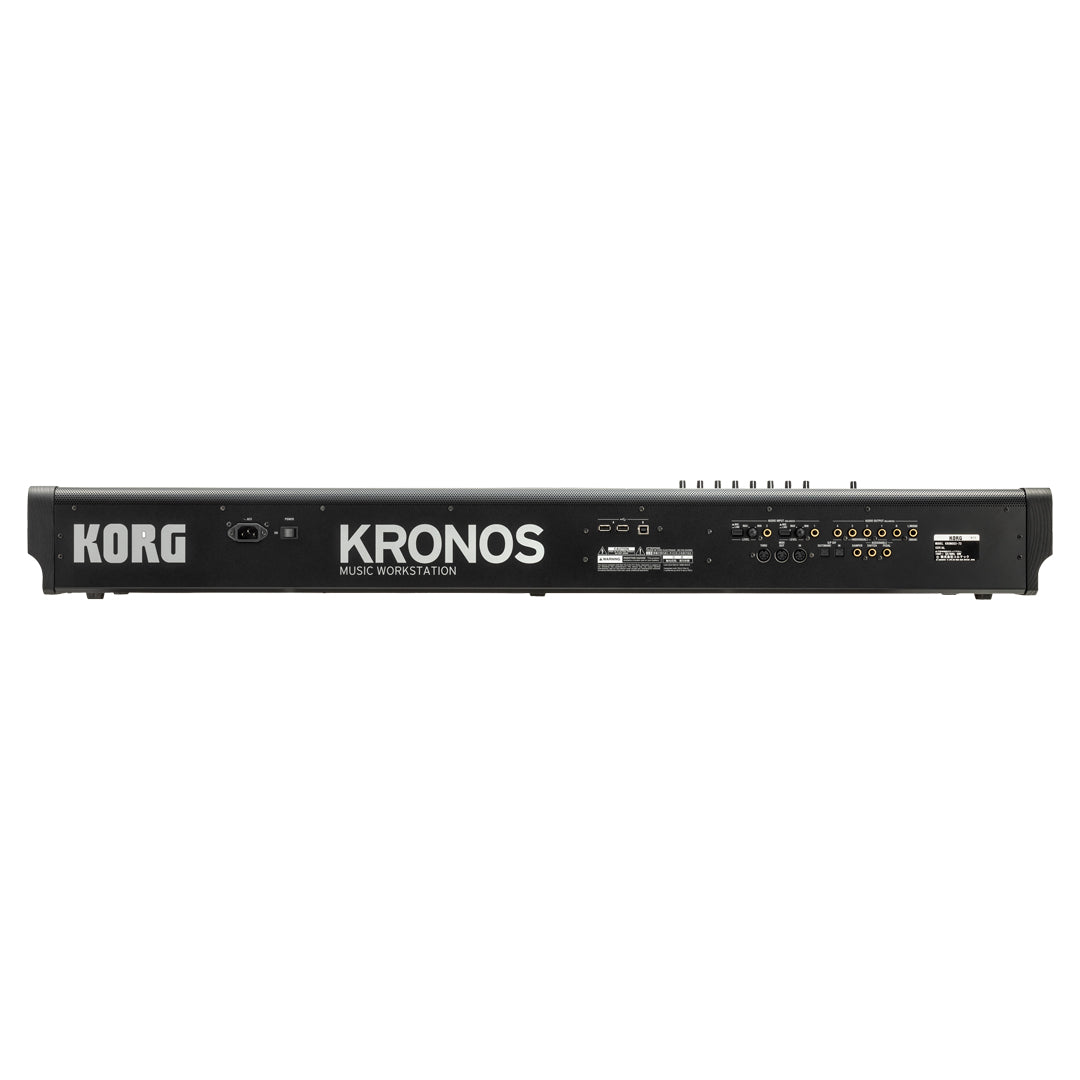

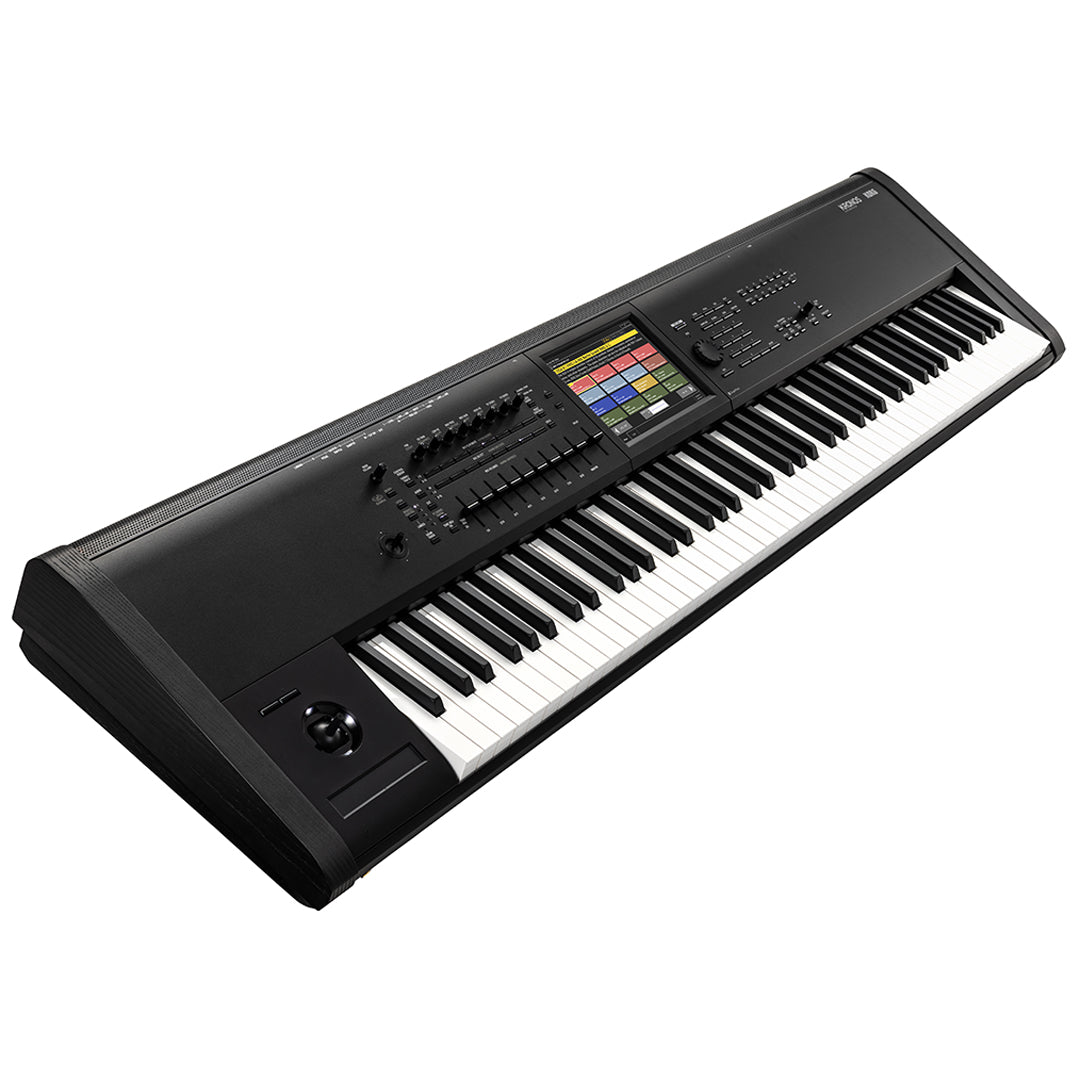

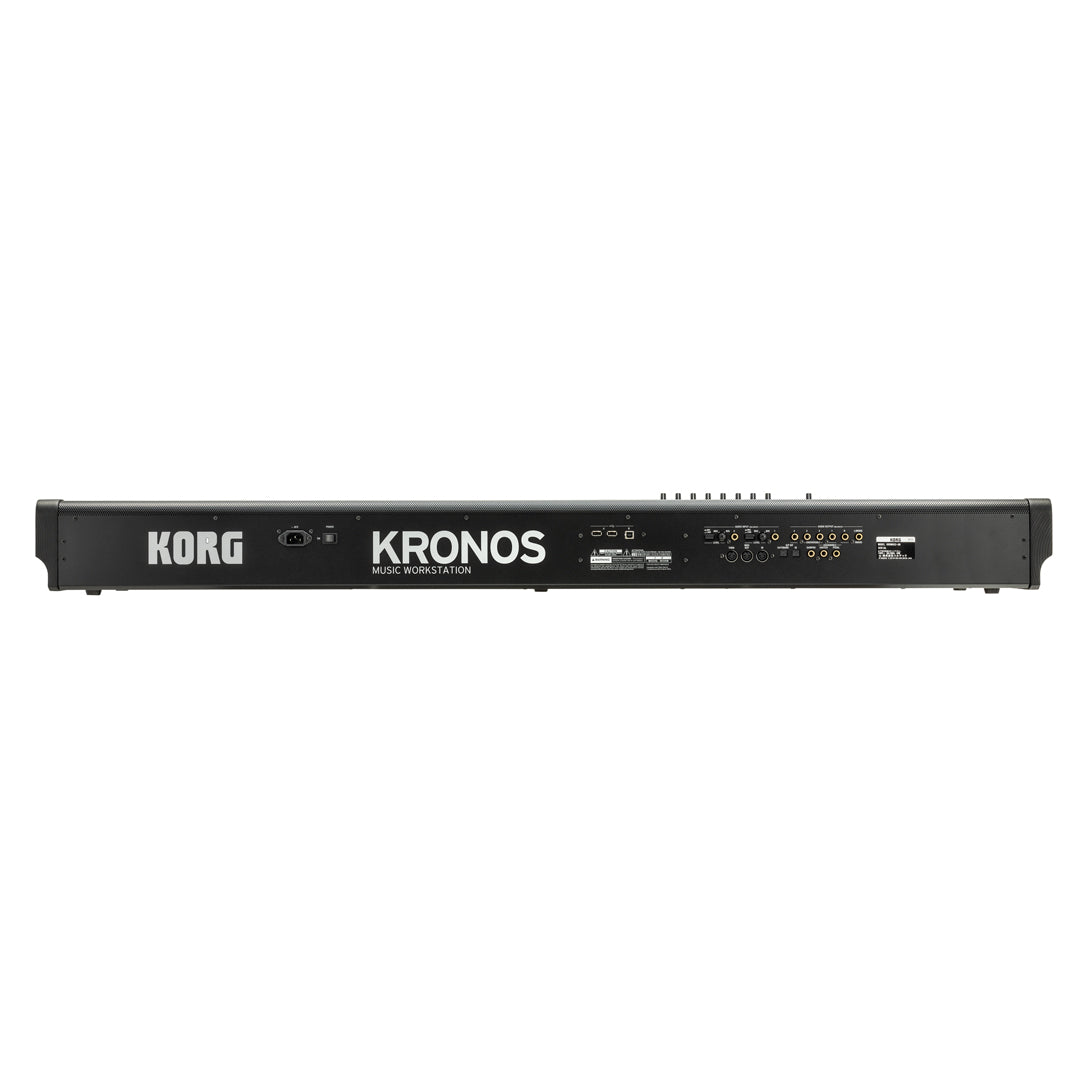
KRONOS
MUSIC WORKSTATION
Tax excluded. Shipping calculated at checkout
KRONOS is back—refreshed, refined, and ready to reclaim its place in the spotlight. The KRONOS with intuitive controls, access to over 300 premium Sound Libraries, and a suite of exclusive features, the newest KRONOS is designed to redefine what’s possible on any stage and in any studio.
Products purchased directly from KORG US qualify for protection under warranty. Read terms: Limited Warranty
Free shipping available, expedited shipping rates displayed at checkout. Read terms: Shipping Policy
We accept returns within 14 days for material or manufacturer defect. Read terms: Return Policy

A Legacy of Innovation: From the M1 to KRONOS 3
For over three decades, KORG has shaped the sound of modern music through innovation in workstation technology.
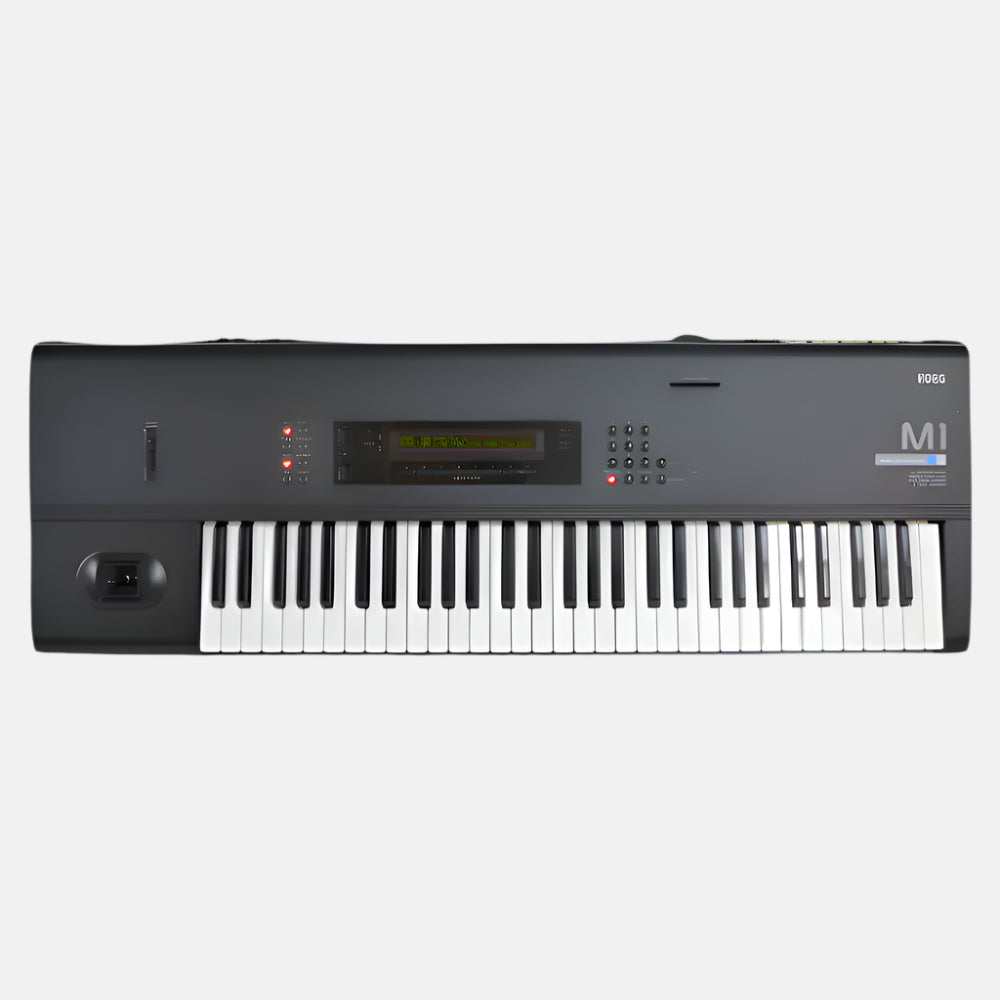
1988
The KORG M1
The KORG M1 was the first true music workstation, combining synthesis, sequencing, and digital effects in a single instrument. It featured a 61-note velocity and aftertouch-sensitive keyboard, 16-note polyphony, 8-track MIDI sequencer, and 4MB of 16-bit PCM ROM—unprecedented at the time. Its built-in effects included reverb, chorus, delay, EQ, distortion, and Leslie speaker simulation, all seamlessly integrated into the workflow. The M1 became one of the best-selling synthesizers in history, famously used on Madonna’s “Vogue” and throughout early 90s house music and commercial TV scores.
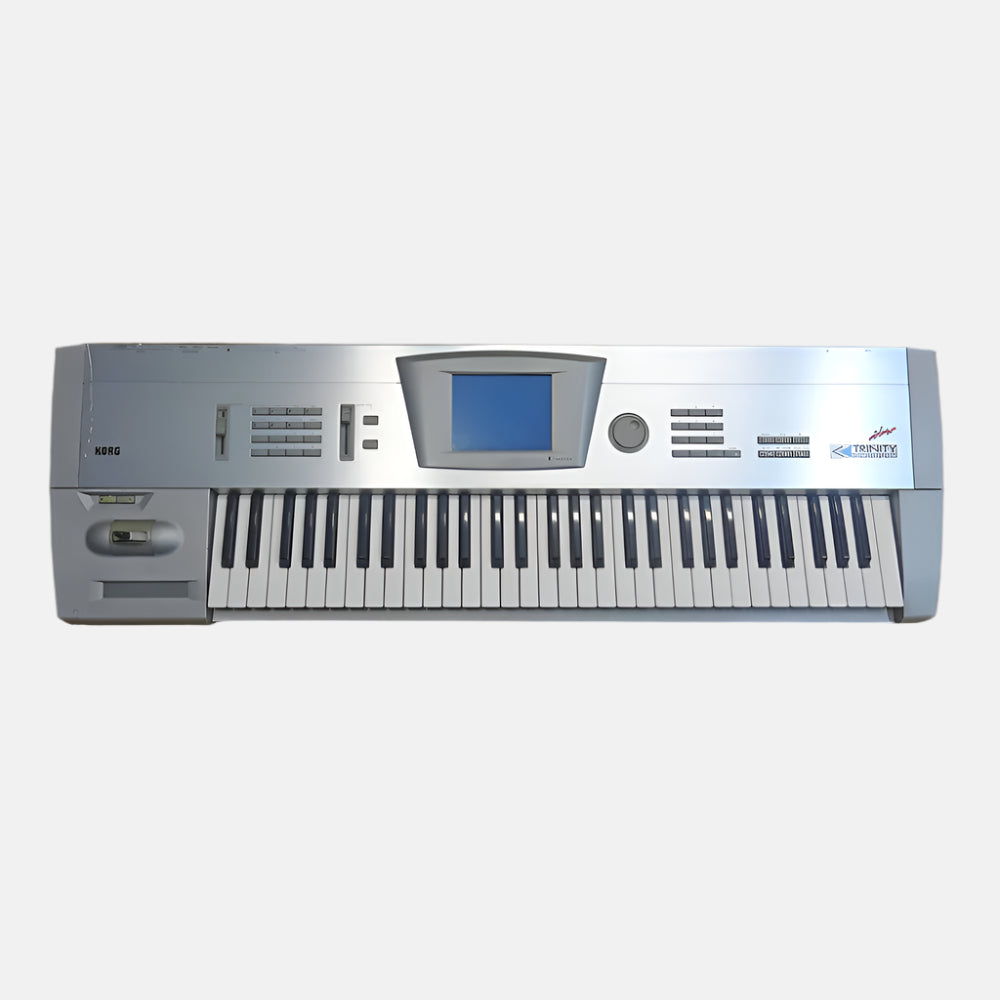
1995
The KORG Trinity
The Trinity introduced a large touchscreen interface, a 61-note semi-weighted keyboard, 32-note polyphony, and the ACCESS synthesis system with 24MB of compressed PCM ROM. It offered modular expansion options such as digital recording (HDR-TRI), Prophecy-derived synthesis (SOLO-TRI), and MOSS physical modeling. Its onboard effects system supported up to eight simultaneous inserts and dual master effects, a significant advancement at the time. The Trinity became a staple for artists like Vangelis and Rick Wakeman and was widely used in studio scoring and electronic music throughout the late 1990s.
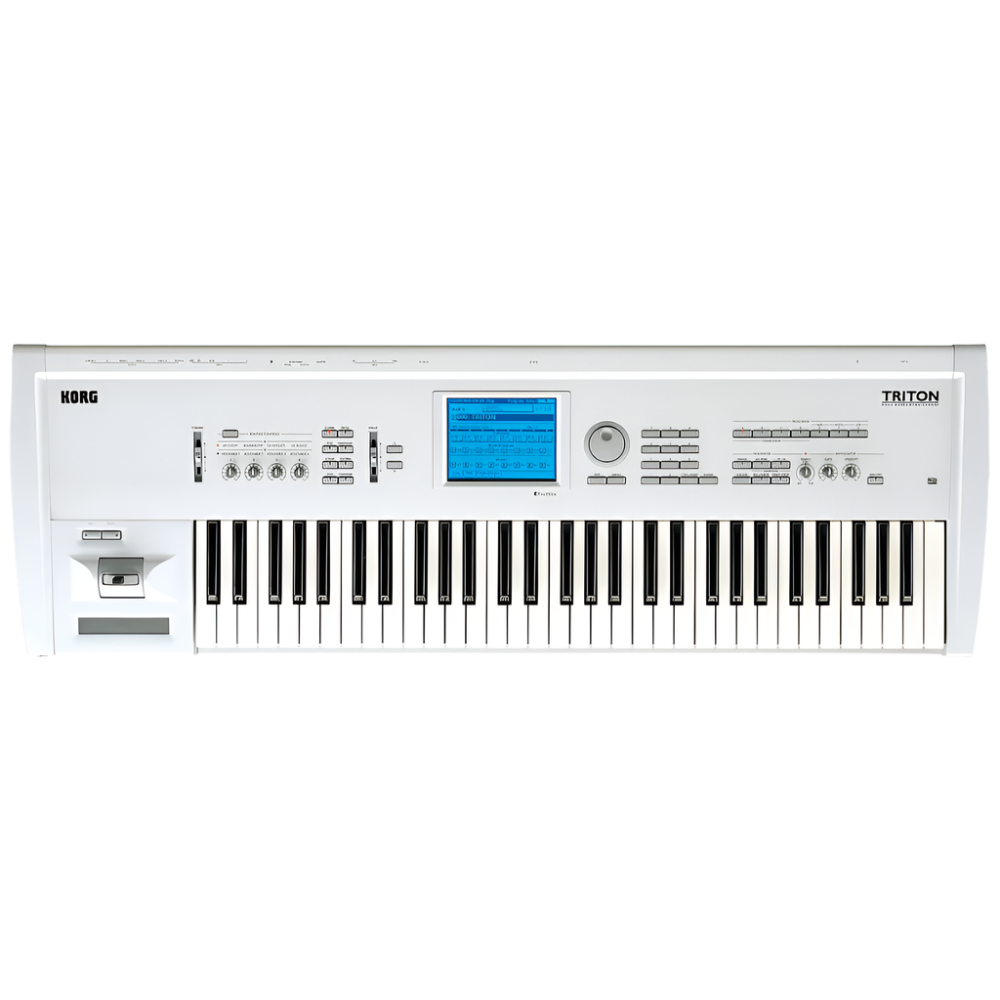
1999
The KORG Triton
The Triton improved upon the Trinity’s foundation with a 62-note polyphonic HI synthesis engine, dual arpeggiators, expanded sample RAM (up to 96MB), and real time sampling capabilities. It supported EXB PCM expansion boards, featured a touch sensitive interface, category-based patch browsing, and a powerful sequencer with Cue Lists and loop functions. The Triton became a key instrument in early 2000s hip hop and R&B production, used by producers like Dr. Dre, The Neptunes, and Lil Jon. Its signature layered pads, electric pianos, and string patches were heard on countless chart-topping hits.
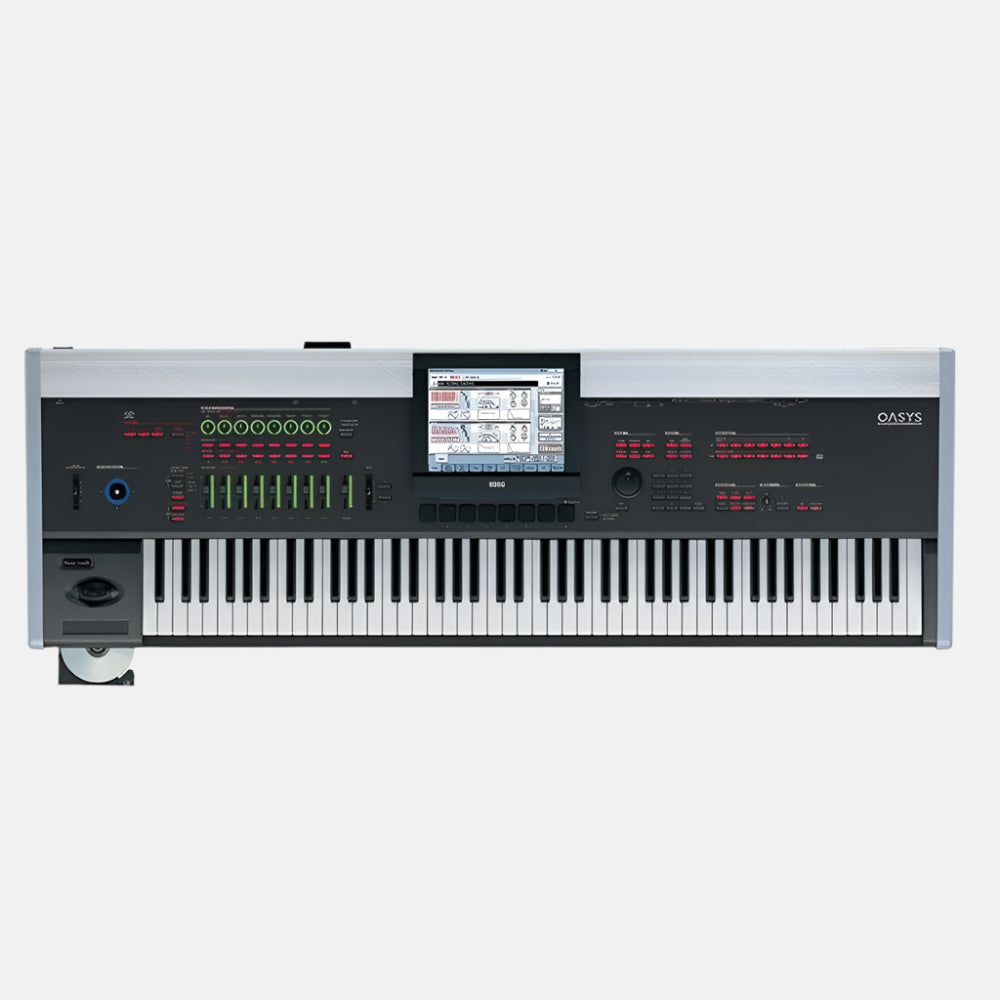
2005
The KORG OASYS
The OASYS was KORG’s most advanced workstation to date, built on a custom Linux OS with a 10.4-inch touchscreen and modular architecture. It launched with multiple synthesis engines including HD1 for PCM, AL1 for virtual analog, CX3 for tonewheel organ, and STR1 for physical modeling, with MOD7 FM synthesis added later. It offered up to 172-note polyphony depending on the engine, supported up to 2GB of RAM, and included 16-track audio and MIDI sequencing with second-generation KARMA. A 40GB internal hard drive enabled sample streaming and expansion through additional PCM libraries. Though expensive, it was embraced by sound designers and performers like Richard Devine and Tony Banks of Genesis and laid the groundwork for KRONOS.
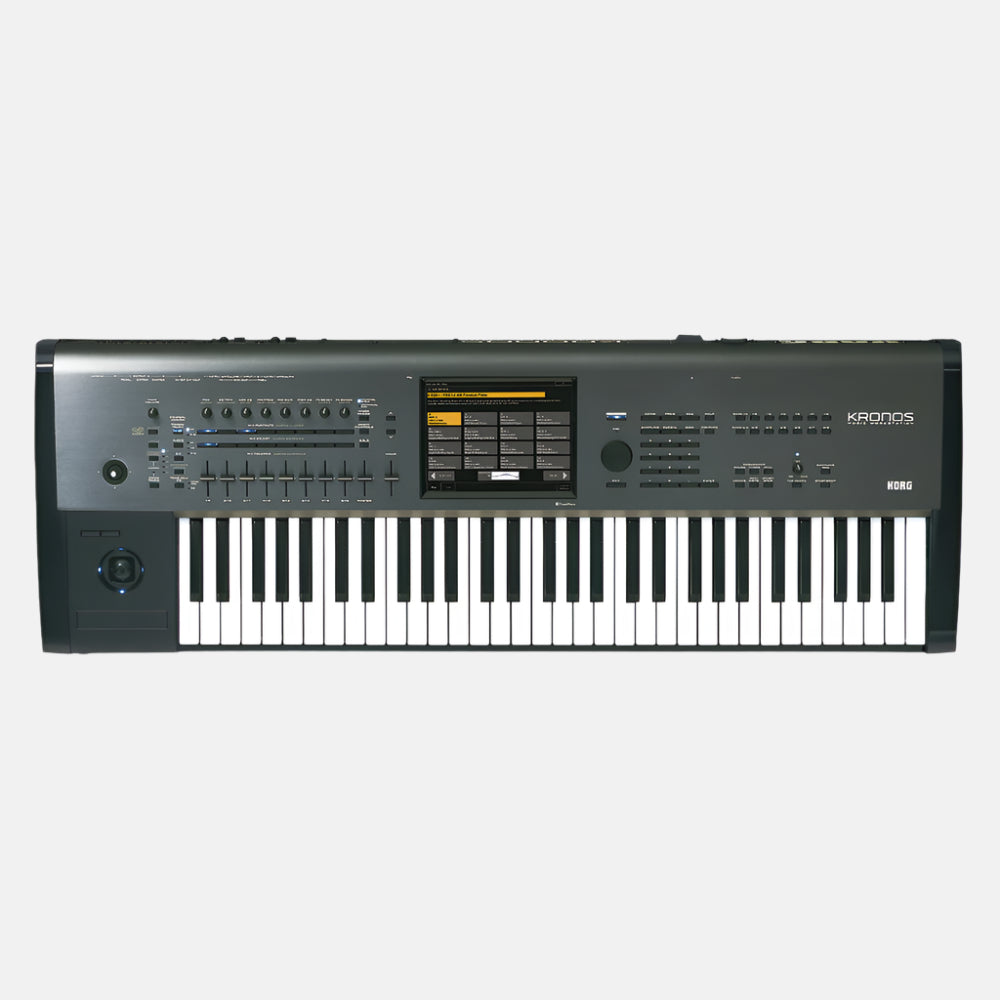
2011
The KORG KRONOS
KRONOS unified nine distinct synthesis engines, including SGX-1 for unlooped piano samples and EP-1 for modeled electric pianos, alongside MOD-7, AL-1, STR-1, and others from OASYS. It introduced SSD-based sample streaming, Smooth Sound Transitions, and an 8-inch color TouchView interface. With up to 2GB RAM, plugin-style editing, dynamic effects routing, and a 16-track audio/MIDI sequencer, KRONOS offered deep control for both live performance and studio production. Artists like Jordan Rudess, Herbie Hancock, Keith Emerson, and Chick Corea integrated KRONOS into their performance and scoring setups.
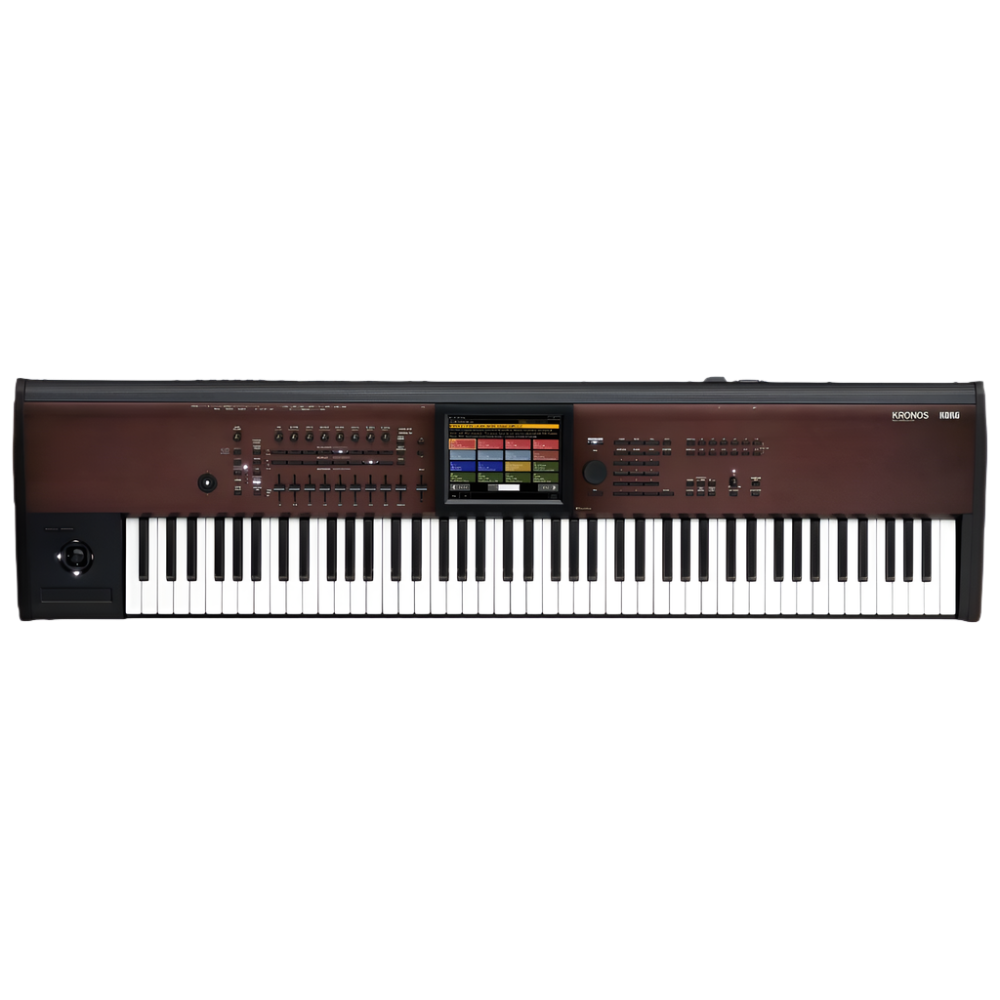
2015
The KORG KRONOS 2
KRONOS 2 refined the original with a redesigned body, new SGX-2 piano engine supporting sympathetic string resonance, and additional factory PCM libraries including Berlin and Japanese grand pianos. It also expanded sound selection with EXs libraries pre-installed and an updated set list mode with drag-and-drop touch controls. KRONOS 2 became a go-to instrument for live touring and session players, continuing its role as the centerpiece for artists like Rudess and Hancock, while expanding into film, worship, and pop production environments.
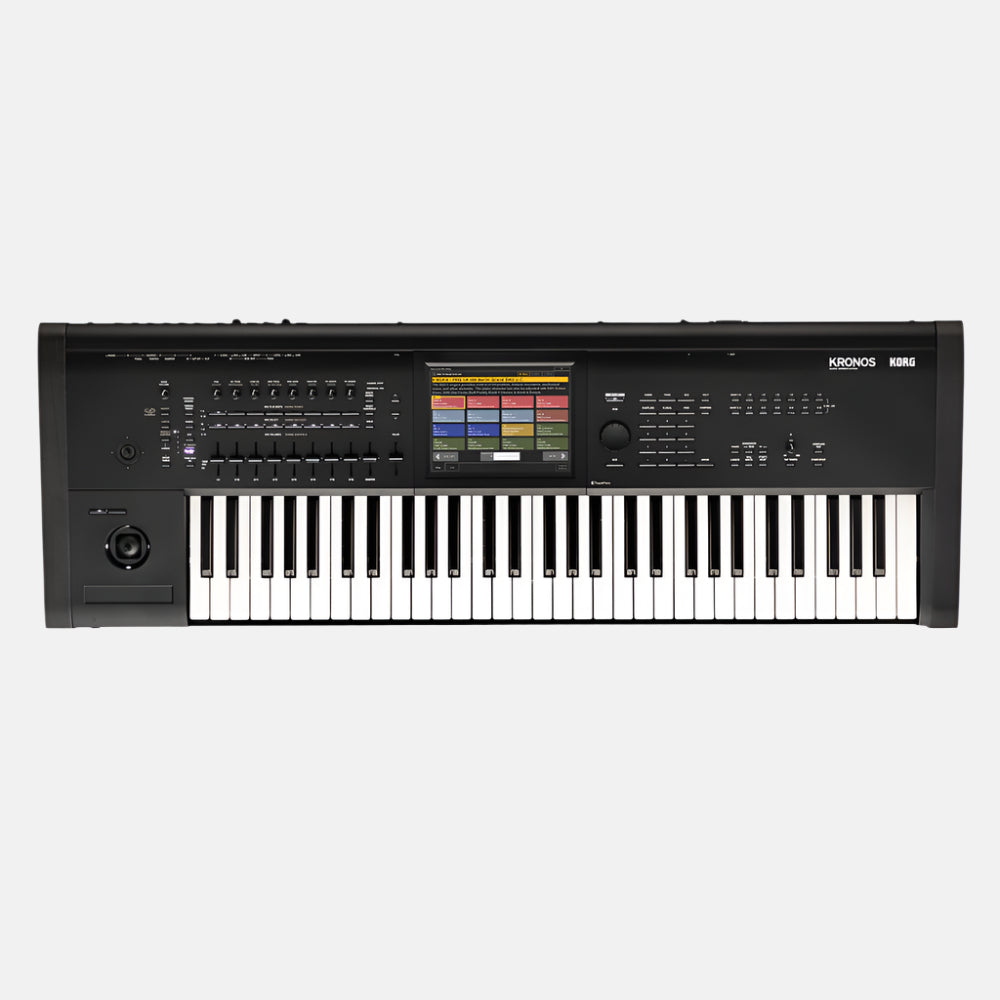
2025
The KRONOS 3
The New KRONOS refines the flagship workstation with upgraded system architecture, faster boot time, enhanced responsiveness, and expanded PCM content including an Italian grand piano and a new modeled Tine electric piano. All nine synthesis engines have been optimized, with improved integration and expanded effects processing. The interface features a more responsive touchscreen, deeper Set List customization, and enhanced sample streaming. Its fourth-generation design introduces subtle yet striking updates, including a durable powder-coated metal body and refined black wood side panels. With curated legacy libraries like Best of TRITON and CX-3 Signature Sounds, full backward compatibility, and support for third-party sound content, KRONOS 3 stands as the most complete and expandable KORG workstation ever, continuing a legacy over three decades in the making.
Why KRONOS?
The Power of Nine Sound Engines in One Instrument
Most keyboards limit you to one or two types of sounds. KRONOS
3 gives you nine.
With nine independent engines, you can mix acoustic pianos, fat analog synths, powerful FM basses, and lush pads—all in the same session,
with no compromises.
SGX-2
Stunning, fully modeled grand pianos
CX-3
Vintage tonewheel organs with real rotary speaker emulation
HD-1
High-definition sampling for rich, realistic instrument sounds
STR-1
Physical modeling for expressive plucked instruments
MOD-7
Classic FM synthesis, perfect for legendary electric pianos & basses
MS-20EX & PolysixEX
Recreate
iconic analog synths from KORG’s past
EP-1
The warmest, most responsive electric pianos ever made
AL-1
Cutting-edge virtual analog synthesis for deep sound design


TouchView Display
The KRONOS features our exclusive TouchView graphic interface, based on a touch-panel LCD screen. By touching objects displayed in the LCD screen, you can select pages, set parameter values, move sliders and knobs,
enter text, connect virtual patch cables, and more.
Bank Select Buttons
Use these buttons to change banks when selecting Programs or Combinations. The LEDs in the buttons light up to show
the current bank.
Joystick
The joystick moves in four directions: left, right, forwards and backwards. Each of the four directions can be used to control different programs or effects parameters depending on the current Program, Combi, or Song. Controls pitch bend up and down, vibrato, and filter LFO (wah).
Control Surface
The Control Surface is the set of 9 sliders, 8 knobs, and 16 switches to the left of the LCD screen. It looks like a mixer, but can do a variety of things such as editing sounds, controlling KARMA, and sending MIDI messages to external devices.
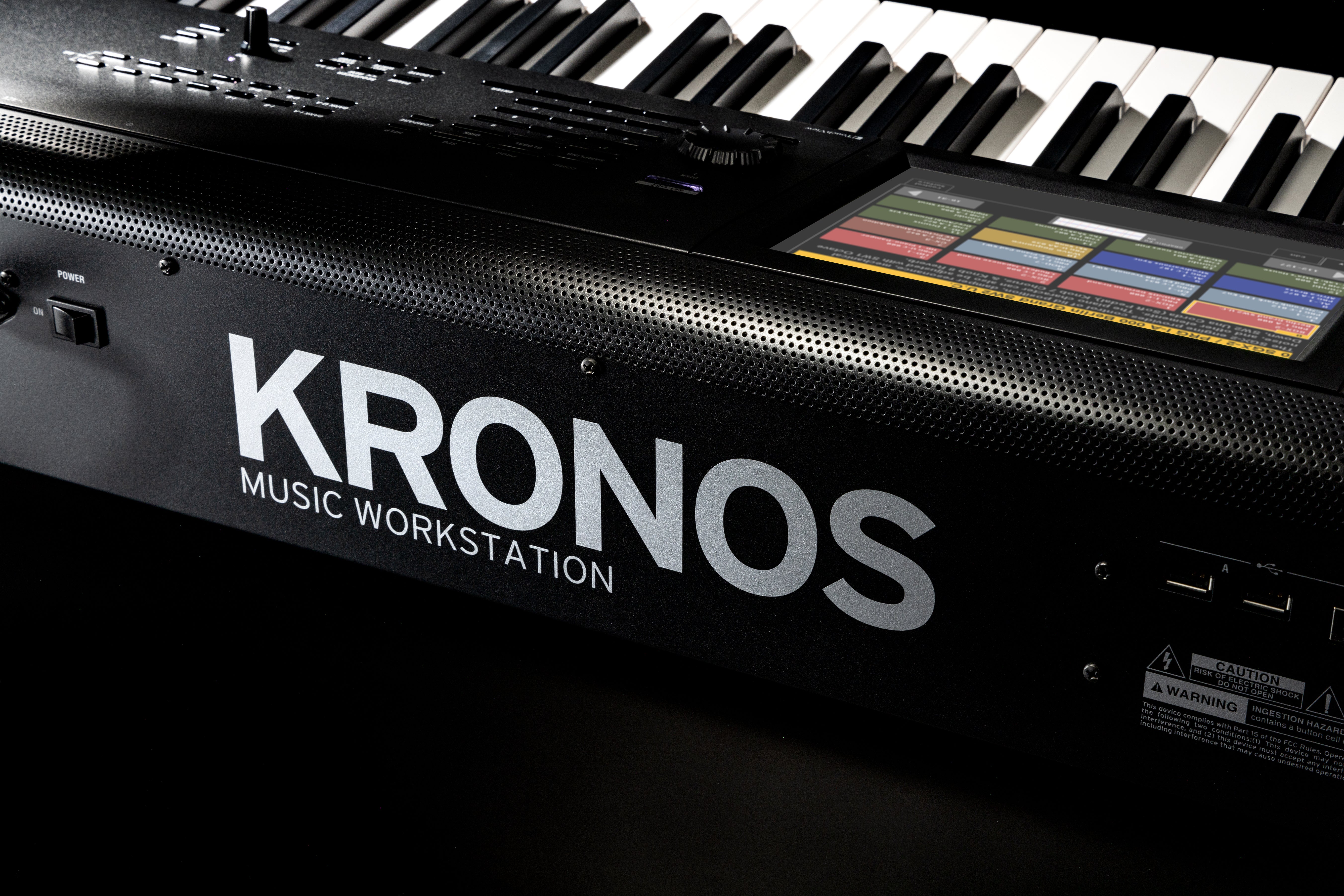
New Sounds, Unmatched Expression
In addition to the thousands of included sound programs and combinations, the new KRONOS introduces 256 additional programs, carefully crafted to elevate your musical creativity. Central to this update are 128 brand-new sound programs, including a stunning Italian piano with gorgeous, transparent resonance, and the Tine EP I Early, an electric piano tone that authentically replicates the earthy, vintage sound of metal rod (tine) mechanisms.

Streamlined Control, Unparalleled Intuitiveness
The KRONOS control system has been meticulously refined over generations to deliver a performance interface as intuitive as it is powerful. Its layout—featuring eight real-time knobs, nine sliders, and a suite of performance controls—remains comfortably familiar, empowering musicians to focus on their craft and perform intuitively.
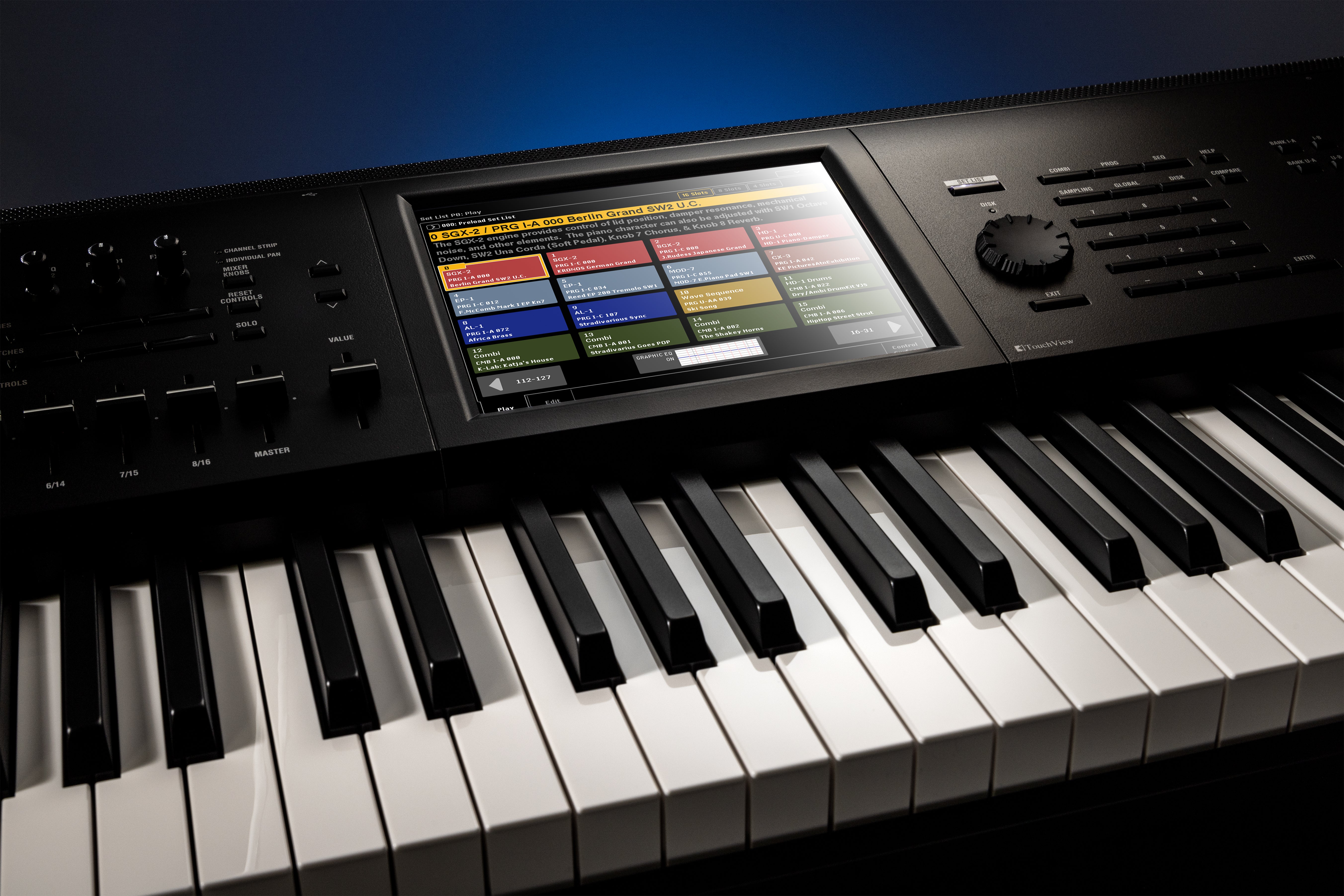
Color TouchView Display
The nerve center of the KRONOS is KORG’s enormous eight-inch (800 x 600 pixel) SVGA color TouchView display.
In addition to simply selecting a sound or choosing a parameter with the touch of a finger, the enhanced Touch-Drag ability allows more detailed control of parameter values. Interactive instruments and panel graphics provide the ability to do everything from adjusting the opening height of a grand piano lid to connecting patch cables on a semi-modular synthesizer model.
The TouchView display also hosts a convenient new Search Function, allowing you to search for (and preview) sounds based on their titles.
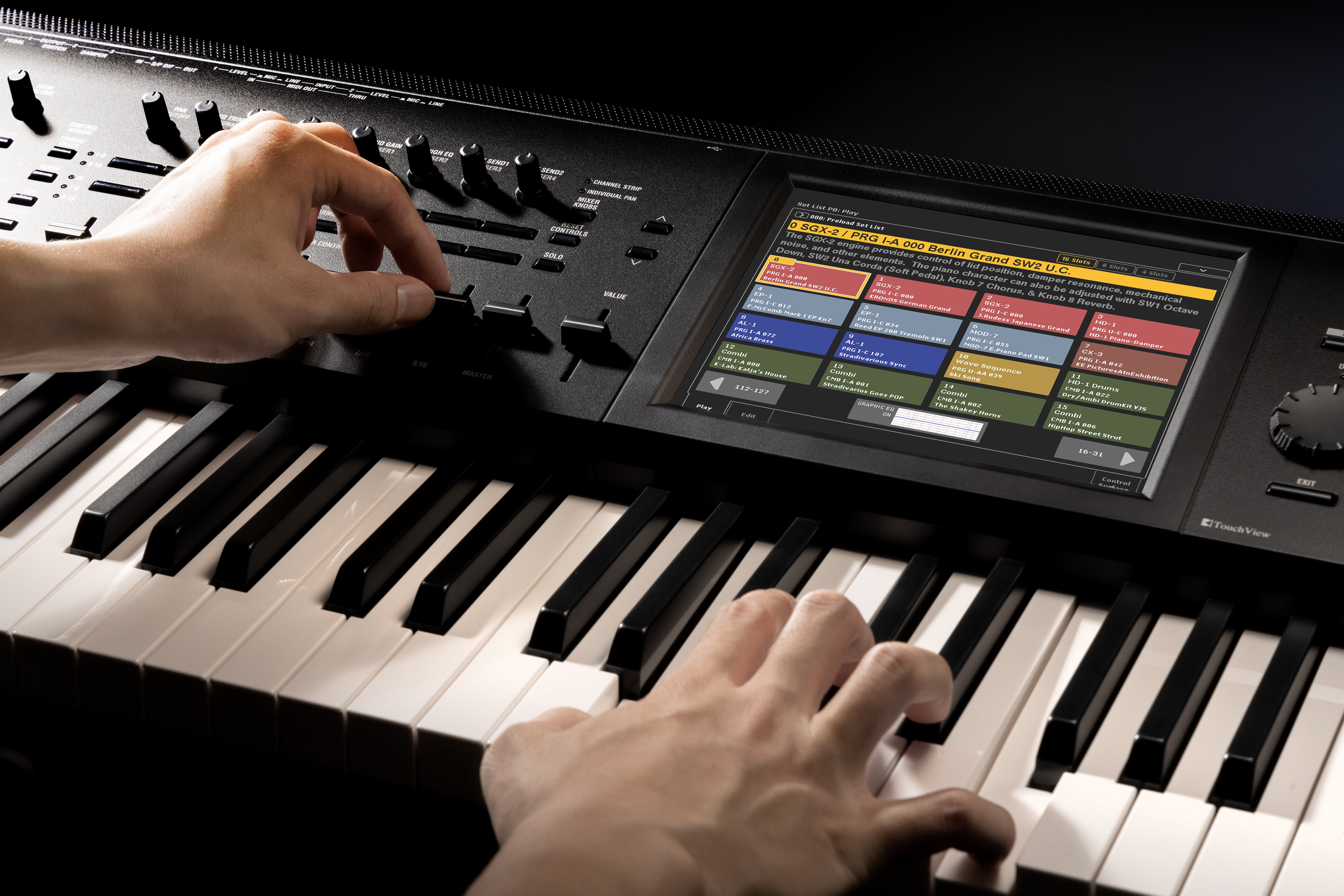
Nine Distinct Sound Engines
Each of the individual KRONOS sound engines is eminently qualified to operate as a stand-alone synthesizer. And each one represents the cutting-edge technology available for that type of sound creation. Exacting programming parameters, real-time controllers, integrated effects, and assignable modulation routings provide incredible control to create custom edits or to empower the ambitious sound designer
KRONOS | Music Workstation
While the hallmark features of KRONOS remain unchanged, its fourth-generation design introduces subtle yet striking updates. The powder-coated metal body offers exceptional durability and a premium tactile feel, while the refined black wood side panels add a sophisticated edge. These enhancements ensure KRONOS not only performs impeccably but also commands attention from any audience.
KRONOS takes performance efficiency to new heights with its significantly improved startup process. Thanks to a reengineered system architecture, startup time is now 60% faster than previous models, drastically reducing downtime. Coupled with an enhanced TouchView interface, KRONOS provides unmatched responsiveness, ensuring every interaction feels instantaneous and intuitive.
SPECIFICATION
System:
System
KRONOS System Version 3.2
Keyboard
88 key: RH3 (Real Weighted Hammer Action 3)
73 key: RH3 (Real Weighted Hammer Action 3)
61 key: Natural Touch Semi Weighted
Tone Generator:
Synthesis Types
9
SGX-2: Premium Piano (Acoustic Piano)
EP-1: MDS Electric Piano (Electric Piano)
HD-1: High Definition Synthesizer (PCM)
AL-1: Analog Synthesizer (Analog Modeling)
CX-3: Tonewheel Organ (Tonewheel Organ Modeling)
STR-1: Plucked Strings (Physical Modeling)
MOD-7: Waveshaping VPM Synthesizer (VPM Synthesis)
MS-20EX: Component Modeling Technology (Analog Modeling)
PolysixEX: Component Modeling Technology (CMT Analog Modeling)
Maximum Polyphony*1*2
SGX-2: 100 voices*3
EP-1: 104 voices
HD-1: 140 voices
AL-1: 80 voices
CX-3: 200 voices
STR-1: 40 voices
MOD-7: 52 voices
MS-20EX: 40 voices
PolysixEX: 180 voices
*1: In rare cases, when a large number of processor-intensive effects are active simultaneously (for instance, more than 14 O-Verbs), polyphony may be slightly reduced.
*2: A portion of the multicore processor in KRONOS is devoted to generating voices, and a separate portion is devoted to generating effects. KRONOS dynamically allocates the voice processing power between the engines as necessary. The quoted maximum numbers of voices apply when 100% of the voice processing power is devoted to a single engine.
*3: 100 dual-stereo notes (equivalent to 400 mono voices)
Preset PCM
314 MB (ROM 1,505 Multisamples, 1,388 Drumsamples)
Build-in Expansion PCM Libraries
EXs1 - ROM Expansion
EXs2 - Concert Grand Piano
EXs3 - Brass & Woodwinds
EXs4 - Vintage Keyboards
EXs5 - ROM Expansion 2
EXs6 - German D Piano
EXs7 - Japanese C Piano
EXs8 - Rock Ambience Drums
EXs9 - Jazz Ambience Drums
EXs17 – SGX-2 Berlin D Piano
EXs18 – KORG EXs Collections
EXs22 - SGX-2 Italian F Piano LE
EXs23 - 2 Church Pianos
EXs206 - A2D 10 Selections
EXs207 - Bolder 10 Selections
EXs208 - K-Sounds 10 Selections
EXs209 - KApro 10 Selections
EXs210 - KARO 10 Selections
EXs211 - Kelfar 10 Selections
EXs212 - Kid Nepro 10 Selections
EXs213 - PCreek 10 Selections Vol.1
EXs214 - PCreek 10 Selections Vol.2
EXs215 - Q Up Arts 10 Selections
EXs216 - Soundiron 10 Selections
EXs217 - SOP 10 Selections
EXs218 - Irish Acts 10 Selections
PCM RAM Capacity:
Approx. 3GB *4
*4: The memory available for Sampling Mode will change based on the use of Expansion PCM libraries and User Sample Banks. Approx. 760 MB is available when shipped from the factory (When loading the file named “PRELOAD.KSC”).
Wave Sequences
598 User memory, 207 Preload
Support for stereo multisamples, synchronization of individual notes, and tempo-based settings.
SGX-2 Program:
Premium Piano
Virtual Memory Technology (VMT) plays large samples directly from the internal SSD
Full key stereo sampling, Chromatically sampled at up to 12 velocity levels, no looping.
Damper resonance and mechanical noise are reproduced.
Modeled String Resonance.
Una Corda sample support
PCM
EXs6:SGX-1 German D Piano
EXs7:SGX-1 Japanese C Piano
EXs12:SGX-1 Austrian D Piano (Option Sound libraries)
8 velocity levels, no Una Corda samples
EXs17:Berlin D Piano
12 velocity levels, includes Una Corda samples
Piano Type
80 (With the factory settings, the 16 varieties of EXs12 SGX-1 Austrian D Piano do not produce sound. The EXs12 option must be downloaded.)
(The 16 types of EXs21 SGX-2 Italian F Piano are the same piano types as the 16 types of EXs22 SGX-2 Italian F Piano LE and refer to the last installation of either EXs21 or EXs22.)
Oscillator Control
Damper Resonance
Damper Noise
Mechanical Noise
Note Release
String Resonance
Una Corda
EP-1 Program
MDS Electric Piano
Tine and reed-type electric pianos powered by Multi-Dimensional Synthesis (MDS), and vintage effects.
Electric Piano Model Types
7
Tine EP I Early, Tine EP I Late, Tine EP II, Tine EP V, Tine EP DMP, Reed EP 200, Reed EP 200A
Oscillator Control
Harmonic Sound Level, Attack Noise, Level, Release Noise Level, Attack Brightness, Hammer Width
Panel Control
Tine Type
Preamp Volume, Tone (Treble, Bass), Vibrate (On/Off, Intensity, Speed), Amp/Cabinet (On/Off, Drive)*5
Reed Type
Preamp Volume, Tone (Treble, Bass), Vibrate (Intensity, Speed), Amp/Cabinet (On/Off, Drive)*5
Effect Types
9
Small Phase, Orange Phase, Black Phase, Vintage Chorus, Black Chorus, EP Chorus, Vintage Flanger, Red Comp, VOX Wah
HD-1 Program
Advanced Vector Synthesis
Control oscillator volumes and synthesis & effects parameters via the Vector Joystick and the tempo-synchronized Vector Envelope.
Structure
Single: only OSC1, Double: OSC1 and OSC2.
Double mode lets you layer two completely separate synth voices, each with their own velocity-switched oscillator, dual filter, EGs, LFOs, etc.
Drums: One drum kit, Double Drums: Two drum kits.
Oscillators
Virtual Memory Technology (VMT) plays large samples directly from the internal SSD.
8 velocity zones per oscillator, with switching, crossfades and layering
Each zone can play mono or stereo Multisamples or Wave Sequences
Filters
Two multi-mode filters per voices (low-pass, high-pass, band-pass and band-reject),
Four-mode filter routings (single, serial, parallel and 24dB mode)
Driver
Per voice non-linear driver and low boost circuit
EQ
Three bands, with sweep-able mid
Modulation
Three envelope generators, two LFOs per voice, common LFO, four key tracking generators, AMS (Alternate Modulation Source), two AMS mixers
EXi Program Common
Advanced Vector Synthesis
Control oscillator volumes and synthesis & effects parameters via the Vector Joystick and the tempo-synchronized Vector Envelope.
Modulation
Common Step Sequencer, AMS (Alternate Modulation Source), Common LFO, 2 Key Tracking Generators
EQ
Three bands, with sweep-able mid
AL-1 Program
Oscillators
Ultra-low-aliasing oscillators
OSC1, OSC2, Sub-oscillator and noise generator; ring modulation, FM and Sync
Audio Input
External audio can be processed through the ring modulator, filter, driver, amp, and EQ
Filters
Two multi-mode filters (low-pass, high-pass, band-pass and band-reject) with four types of filter routings (single, serial, parallel and 24dB mode),
Multi Filter mode (only Filter-A; modulatable mix of Low Pass, High Pass, Band Pass, and dry input, for creating a wide variety of unique filter types and effects)
Driver
Per-voice non-linear driver and low boost circuit
Modulation
Five Envelope generators, four per-voice LFOs, two AMS Mixers; Per-voice Step Sequencer.
CX-3 Program
Tonewheel Organ Modeling
Phase-synchronous tonewheels (clean and vintage modes), percussion, key click, wheel brake
EX Mode
Four additional, user-specified drawbars, and expanded percussion.
Internal Effects
Rotary speaker, vibrato/chorus, amp modeling with overdrive, 3-band EQ
Drawbar Control
Controlled via nine front-panel sliders (via Tone Adjust)
Split
Upper, Lower (even in EX mode)
Modulation
Two AMS mixers
STR-1 Program
Physically Modeled String
Includes physically modeled damping, decay, dispersion, nonlinearity, harmonics, dual pickups, and more.
Most string parameters can be controlled in realtime.
String Excitation
Three independent excitation sources can be used simultaneously: Pluck, Noise, and PCM.
16 preset “pluck” types, with modulatable width and randomization. Noise generator with saturation and dedicated low pass filter
PCM Oscillator:
KORG’s ultra-low-aliasing technology, as introduced in the HD-1;
4 velocity zones per oscillator;
Uses any mono Multisamples, including ROM, EXs, User Sample Bank, or Sampling Mode.
Supports Virtual Memory.
Excitation Filter:
Dedicated 2-pole multimode filter for shaping the string excitation.
Filter can be enabled/disabled separately for each excitation source.
Low Pass, High Pass, Band Pass, and Band Reject modes
Audio Input and Feedback
Run real-time audio through the string, including feedback through effects.
Modeled feedback includes modulate-able instrument-to-amp distance and orientation.
Filters
Dual multi-mode filters per voice; Single, Serial, Parallel (with split stereo output), and 24dB (4-pole) configurations. Low Pass, High Pass, Band Pass, and Band Reject modes
Multi Filter Mode (Filter A only).
Modulatable mix of Low Pass, High Pass, Band Pass, and dry input, for creating a wide variety of unique filter types and effects
Modulation
5 Envelopes, 4 per-voice LFOs, 2 Key Track generators, String Tracking generators, 4 AMS Mixers.
MOD-7 Program
Waveshaping VPM Synthesizer
Combines Variable Phase Modulation (VPM), Waveshaping ring modulation, PCM sample playback, and subtractive synthesis; Able to convert-load SYX files.
Oscillators
6 VPM/Waveshaper/Ring Modulation Oscillators:
Phase and modulatable pitch per oscillator.
101 Waveshaper tables plus modulatable Drive and Offset.
Use as oscillators, or as Waveshapers or Ring Modulators for other signals.
PCM Oscillator:
KORG’s ultra-low-aliasing technology, as introduced in the HD-1.
4 velocity zones per oscillator.
Uses any mono Multisamples, including ROM, EXs, User Sample Bank, or Sampling Mode. Supports Virtual Memory.
Audio input
Run real-time audio through the VPM Oscillators and filters.
Filters
Dual multi-mode filters per voice. (Low Pass, High Pass, Band Pass, and Band Reject modes)
Two types of filter looping (Parallel and 24 dB “4-Pole”)
Multi Filter mode (Filter A only):
Modulatable mix of Low Pass, High Pass, Band Pass, and dry input, for creating a wide variety of unique filter types and effects
Patch Panel
Supports both preset algorithm (78 types) selection and free patching.
Three 2-in, 1-out mixers for scaling and merging audio, fully modulatable, with phase inversion.
Main 6-input stereo mixer, with modulatable pan and volume, plus phase inversion
Modulation
10 Envelopes, 4 per-voice LFOs, 9 Key Tracking generators, Per-voice Step Sequencer, 4 standard AMS Mixers plus 4 simple AMS Mixers.
MS-20EX Program
Oscillators
Ultra-low-aliasing oscillators; VCO1, VCO2, Ring Mod, Pink and White Noise Generator
Audio Input
Run real-time audio through the synthesis engine and ESP (External Signal Processor)
Filters
12dB/octave High Pass and Low Pass self-resonant filters
ESP section:
24dB/octave Low Cut and High Cut filters, available per voice.Patch PanelPatchable audio and modulation, at audio rates
Patch Points
Keyboard:
Keyboard CV Out, Keyboard Trigger Out, VCO1+VCO2 CV In, VCO2 CV In
VCO:
VCO1+VCO2 External Frequency Control In, VCO1 Out, VCO2 Out
VCF:
External Signal In, External HP Filter Cutoff Frequency Control In, External LP Filter Cutoff Frequency Control In, HPF Out, LPF In, LPF Out
VCO+VCF:
Total External Modulation In
VCA:
External Initial Gain Control In, VCA In
EG:
EG1 Envelope Signal Normal Out, EG1 Envelope Signal Reverse Out, EG1+EG2 Trigger In, EG1 Trigger In, EG2 Envelope Signal Reverse Out
MG:
Triangle Out, Rectangle Out
Noise Generator:
Pink Noise Out, White Noise Out
Sample and Hold:
Clock Trigger In, Sample Signal In, S/H Out
Modulation VCA:
Control Voltage In, Signal In, Signal Out
Manual Controller:
Control Wheel Out, Momentary Switch
ESP:
Signal In, AMP Out, BPF In, BPF Out, F-V CV Out, Envelope Out, Trigger Out
Others:
EXi Audio In, Mixer 1 In, Mixer 1 Out, Mixer 2 In, Mixer 2 Out
ESP (External Signal Processor)
Use incoming audio as a trigger and/or CV source.
Modulation
Original DAR (Delay, Attack, Release) and HADSR (Hold, Attack, Decay, Sustain, Release) EGs 1 &2,
Original MG (with MIDI sync), Sample-and- Hold, MVCA,
KRONOS: 4 additional multi-stage Envelopes, 4 additional per-voice LFOs, and 4 AMS Mixers.
PolysixEX Program
Oscillators
VCO:
Saw, Pulse, PWM
Sub Oscillator:
Off, 1 octave below, 2 octaves below
Filter
24dB (4-Pole) Octave Low Pass self-resonant filter
Effects
Integrated Polysix Chorus, Phaser, and Ensemble
Arpeggiator
Integrated MIDI-synced arpeggiator, with adjustable Range, Mode, and Latch
Modulation
Polysix: Original ADSR EG and MG (with MIDI sync).
KRONOS: 2 additional multi-stage Envelopes, 2 additional per-voice LFOs, and 4 AMS Mixers.
Combination
Number of Timbres, Master Keyboard Functionality
16 Maximum
Keyboard and velocity splits, layers, and crossfades of up to 16 Programs and/or external MIDI Devices
The tone adjust parameter function lets you modify program settings, and the master keyboard function lets you control external MIDI devices
Advanced Vector Synthesis
Control oscillator volumes and synthesis & effects parameters via the Vector Joystick and the tempo-synchronized Vector Envelope.
Drumkit
System
Assignable stereo/mono samples with 8 velocity zones per oscillator (with crossfade functions)
Number of Programs/Combinations/Drum kits
User Memory Programs
2,560 (2,176 [1,152 HD-1+1,024 EXi] come preloaded)
User Memory Combinations
1,792 (768 come preloaded)
User Memory Drum Kits
264 (80 come preloaded)
256 GM Level2 preset programs + 9 GM Level 2 drum preset programs
Set List
Number of Set Lists/Slots
128 set lists, 128 slots per set list
Each set list provides a 9-band graphic EQ, and a Tone Adjust function that allows program settings to be adjusted.
Transpose setting.
Hold Time setting of Smooth Sound Transition (SST) supported for each slot.
Sampling
System
Open Sampling System (resampling, In-Track sampling)
Bit Depth/Sampling Frequency
RAM: 16-bit/48 kHz stereo/mono sampling
DISK: 16 or 24-bit/48 kHz
Sampling Time
RAM: Depends on the amount of available PCM RAM
DISK: Maximum 80 minutes stereo (879MB: 16bit)
Sample Locations
16,000 samples/4,000 multisamples (128 indexes per multisample)
Ripping
Direct sampling (ripping) from audio CD (CD-DA)
Formats
KORG format, AKAI S1000/S3000 data (with advanced Program parameter conversion); SoundFont 2.0, AIFF, and WAVE formats
Editing
Time Stretch, Time Slice, Crossfade Loop, and other standard editing features.
Effects
Insert Effects
12
Stereo in / stereo out
Master Effects
2
Stereo in / stereo out
Total Effects
2
Stereo in / stereo out
Timbre EQ
One 3-band EQ for each timbre/track
Effect Types
197
Modulation
Dynamic Modulation and Common LFO
Effects Control Busses
Stereo side-chaining for compressors, gates, vocoders, etc.
Effect Presets
Total 783 preset, Maximum 32 per 1 effect (Preset User)
KARMA
KARMA Modules
One module in Program mode, four modules in Combination and Sequencer modes
Generated Effects (GE)
2,048 presets, 1,536 Users (96 come Preload)
Controllers
On/Off, Latch, Chord, Assign, Module, Control, KARMA Realtime Control Sliders [1] – [8], KARMA Scenes [1] – [8], KARMA Switches [1] – [8], KARMA Wave-Sequencing, GE Sub Category, Freeze Randomize, Time Signature Control, Tempo Synchronize, Auto RTC (Real Time Control) setup
Drum Track Patterns
718 preset (common with the preset patterns of the MIDI sequencer)
1,000 user patterns
Patterns created in Sequencer mode can be converted to drum track user patterns.
Trigger Mode/Sync/Zone settings can be specified.
Sequencer/HDR
Tracks
16-track MIDI sequencer + 16-track hard disk recorder + 1 master track.
Number of Songs
200 songs
Resolution
1/480
Tempo
40.00 – 300.00 (1/100 BPM resolution)
Maximum Memory
400,000 MIDI events or 300,000 audio events
MIDI Tracks
16 tracks plus the master track
718 preset/100 user patterns (per song)
18 preset/16 user template songs,
Audio Tracks
16-track playback, 4-track simultaneous recording, WAV file format 16bit/24bit.
Other Functions
RPPR (Realtime Pattern Play and Record) (1 Pattern set per song), Auto Song Setup function
General
Disk Mode
Load, save, utility, audio CD burning, audio CD playback, data filer function (save/load MIDI System Exclusive data), CD-R/RW (UDF format read/write), ISO9660 Level 1.
Controllers
Vector joystick, joystick, ribbon controller, switches 1 & 2
Control Surface:
Control Assign Switches:
Assigns the Control Surface to Timber/Track, Audio, External, Realtime Knobs/KARMA,
Tone Adjust/EQ
Mixer Knobs Switch:
Assigns the Mixer Knobs to either Channel Strip or Individual Pan, Reset Control Switch, Solo Switch, Knobs 1-8, Switches 1-8(Upper Row), Switches 1-8 (Lower Row), Sliders 1-8, Master Slider
KARMA Control:
On/Off, Latch, Module Control
DRUM TRACK:
On/Off
Display
TouchView graphical user interface, 8 inch color TFT, SVGA (800x600 dots), adjustable brightness
Outputs
== Analog ==
(MAIN) L/MONO, R:
1/4” TRS Balanced
Output Impedance: 350 Ω Stereo; 175 Ω Mono (L/MONO Only),
Nominal Level: +4.0 dBu,
Maximum Level: +16.0 dBu (when load impedance is 600 Ω or greater)
MAIN VOLUME knob controls only AUDIO OUTPUT (MAIN) L/MONO and R
Individual 1-4:
1/4” TRS Balanced
Output Impedance: 350 Ω Stereo; 175 Ω Mono,
Nominal Level: +4.0 dBu,
Maximum Level: +16.0 dBu (when load impedance is 600 Ω or greater)
Headphones:
1/4” stereo phone jack, Output impedance: 33 Ω, Maximum Level: 60+60 mW (when load impedance is 33 Ω),
MAIN VOLUME knob (link with AUDIO OUTPUT (MAIN))
== Digital ==
S/P DIF:
Optical, 24-bit, IEC60958, EIAJCP-1201, Sample Rate: 48 kHz, (the same signals as L/MONO, R)
Digital output of the same signals as AUDIO OUTPUT (MAIN) L/MONO and R
USB-B:
24-bit, Sample Rate: 48 kHz, 2 channels
(Digital output of the same signals as AUDIO OUTPUT (MAIN) L/MONO and R)
Inputs
== Analog ==
Audio Inputs 1 and 2:
1/4” TRS Balanced
MIC/LINE input level switches, LEVEL knobs
Input Impedance: 10 kΩ
Nominal Level: LINE
+4 dBu (LEVEL knob = min), –36 dBu (LEVEL knob = max)
Nominal Level: MIC
–22 dBu (LEVEL knob = min), –62 dBu (LEVEL knob = max)
Maximum Level: LINE
+16 dBu (LEVEL knob = min), –24 dBu (LEVEL knob = max)
Maximum Level: MIC
-10 dBu (LEVEL knob = min), –50 dBu (LEVEL knob = max)
Source Impedance: 600 Ω
Signal to noise ratio: 95 dB (typical)
Dynamic range: 95 dB (typical)
Crosstalk: 95 dB, at 1 kHz (typical)
== Digital ==
S/P DIF:
Optical, 24-bit, IEC60958, EIAJCP-1201, Sample Rate: 48 kHz
USB-B:
24-bit, Sample Rate: 48 kHz, 2 channels
Control Inputs
Damper pedal (half damper supported), assignable switch, assignable pedal
MIDI
In, Out, Thru
USB*5
USB A (TYPE A) x 2, For connection to external USB devices (QWERTY keyboards, MIDI controllers, ethernet adaptors, and storage)
USB B (TYPE B) x 1, MIDI/audio interface
MIDI: 1 (16 channel) input / 1 (16 channel) output
Audio: 2 channel input / 2 channel output
*5 USB high-speed ports (supports 480Mbps)
Disk Drives
120 GB SSD (2.5”)
Power Consumption
40W
Dimensions(W x D x H)
61 key: 1,064 x 363 x 134 mm / 41.89” x 14.29” x 5.28”
73 key: 1,245 x 370 x 148 mm / 49/02” x 14.57” x 5.83”
88 key: 1,457 x 370 x 148 mm / 57.36” x 14.57” x 5.83”
Weight
61 key: 14.2 kg / 31.31 lbs
73 key: 20.4 kg / 44.97 lbs
88 key: 23.4 kg / 51.59 lbs
Accessories
AC cord
Principal Specifications
Frequency Response
20Hz-22kHz, +/-1.0dB, 10k Ω load
THD+N
20Hz-22kHz, 0.01%, 10k Ω load (typical)
S/N
95dB (typical)
Dynamic Range
95dB (typical)
Crosstalk
95dB, at 1kHz (typical)
* All product, company, and standard names are trademarks or registered trademarks of their respective holders.
* Appearance and specifications of products are subject to change without notice.
* The color of the actual instrument may differ slightly from the image shown here.
* Since natural wood is used in the side panels of this instrument, there will be individual differences in the grain and figuration of the wood.
DIMENSION
61 key: 1,064 x 363 x 134 mm / 41.89” x 14.29” x 5.28”
73 key: 1,245 x 370 x 148 mm / 49/02” x 14.57” x 5.83”
88 key: 1,457 x 370 x 148 mm / 57.36” x 14.57” x 5.83”
WEIGHT
61 key: 14.2 kg / 31.31 lbs
73 key: 20.4 kg / 44.97 lbs
88 key: 23.4 kg / 51.59 lbs
You may also like

